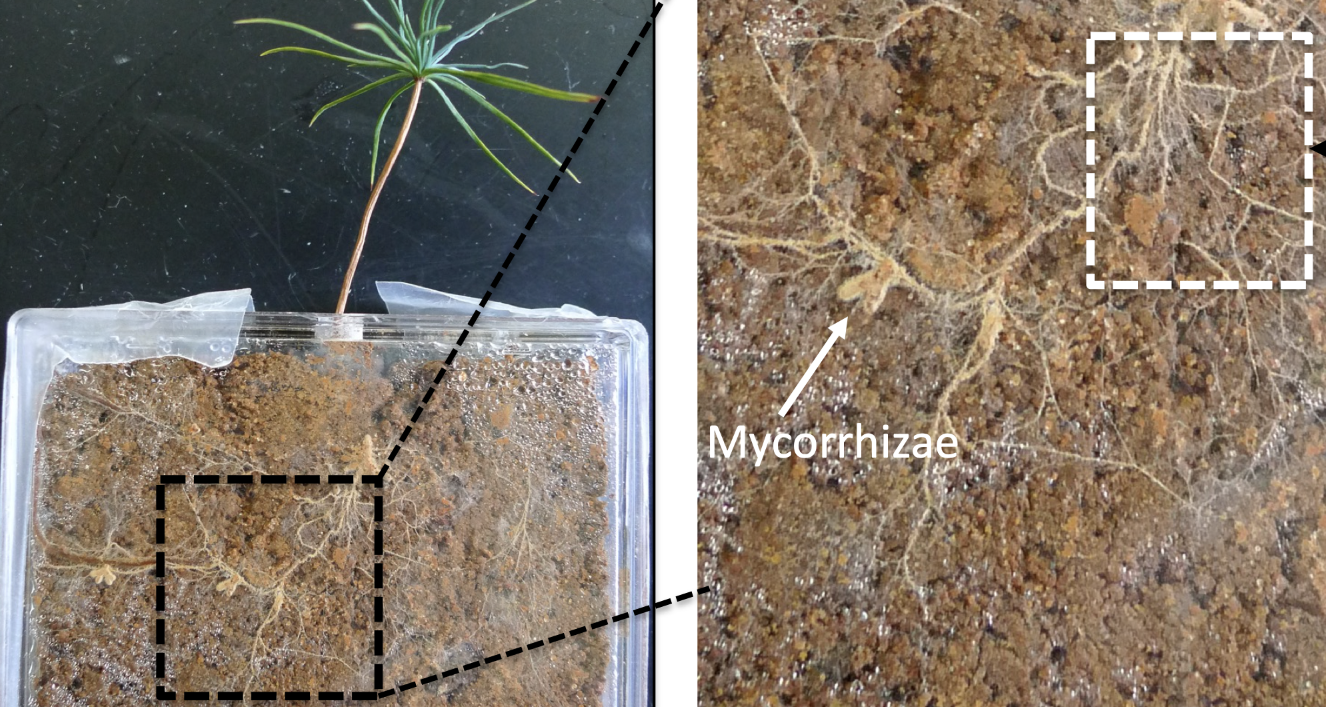Resumen
Each gram of rich soil can harbor 100 million to a billion microorganisms, meaning every inch of our soil is alive (Raynaud and Nunan 2014) (Fig. 1). These underground organisms keep soil healthy. Balancing the community of microbes can benefit plant yield, plant health, and soil sustainability. While it is recognized that many soil microbes perform key roles in crop productivity, the importance of these underground activities is easily overlooked because of their small size. By focusing on a specific group of microbes living on or near plant roots, this publication provides understanding for these questions: Who are these microbes and how do they improve plant and soil health?
Citas
Augé, R. M., H. D. Toler, and A. M. Saxton. 2015. “Arbuscular Mycorrhizal Symbiosis Alters Stomatal Conductance of Host Plants More under Drought Than under Amply Watered Conditions: A Meta-Analysis.” Mycorrhiza. 25: 13-24. https://doi.org/10.1007/s00572-014-0585-4
Alami, Y., W. Achouak, C. Marol, and T. Heulin. 2000. “Rhizosphere Soil Aggregation and Plant Growth Promotion of Sunflowers by an Exopolysaccharide-Producing Rhizobiumsp. Strain Isolated from Sunflower Roots.” Applied and Environmental Microbiology. 66(8): 3393-3398. https://doi.org/10.1128/AEM.66.8.3393-3398.2000
Behie, S. W., and M. J. Bidochka. 2014. “Nutrient Transfer in Plant-Fungal Symbioses.” Trends in Plant Science. 19(11): 734-740. https://doi.org/10.1016/j.tplants.2014.06.007
Berendsen, R. L., C. M. J. Pieterse, and P. A. H. M. Bakker. 2012. “The Rhizosphere and Plant Health.” Trends in Plant Science. 17(8): 478-486. https://doi.org/10.1016/j.tplants.2012.04.001
Cahanovitc, R., S. Livne-Luzon, R. Angel, and T. Klein. 2022. “Ectomycorrhizal Fungi Mediate Belowbground Carbon transfer Between Pines and Oaks.” ISME Journal. 16: 1420-1429. https://doi.org/10.1038/s41396-022-01193-z
de Bary, A. 1879. Die Erscheinung der Symbiose. Strassburg, Germany: Verlag von Karl J.Trubner. https://doi.org/10.1515/9783111471839
Gougoulias, C., J. M. Clark, and L. J. Shaw. 2014. “The Role of Soil Microbes in the Global Carbon Cycle: Tracking the Below-ground Microbial Processing of Plant-derived Carbon for Manipulating Carbon Dynamics in Agricultural Systems.” Journal of Science and Food Agriculture. 94(12): 2362-2371. https://doi.org/10.1002/jsfa.6577
Khan, M. A., S. Asaf, A. L. Khan, R. Jan, S. -M. Kang, K. -M. Kim, and I. -J. Lee. 2020. “Thermotolerance Effect of Plant Growth-promoting Bacillus cereus SA1 on Soybean During Heat Stress.” BMC Microbiology. 20: 175. https://doi.org/10.1186/s12866-020-01822-7
Kumari, S., A. Vaishnav, S. Jain, A. Varma, and D. K. Choudhary. 2015. “Bacterial-mediated Induction of Systemic Tolerance to Salinity with Expression of Stress Alleviating Enzymes in Soybean (Glycine max L. Merrill).” Journal of Plant Growth Regulation. 34: 558-573. https://doi.org/10.1007/s00344-015-9490-0
Kuzyakov, Y. 2002. “Review: Factors Affecting Rhizosphere Priming Effects.” Journal of Plant Nutrition and Soil Science. 165(4): 382-396. https://doi.org/10.1002/1522-2624(200208)165:4%3C382::AID-JPLN382%3E3.0.CO;2-%23
Li, J., C. Wang, W. Liang, and S. Liu. 2021. “Rhizosphere Microbiome: The Emerging Barrier in Plant-Pathogen Interactions.” Frontiers in Microbiology. 12: 772420. https://doi.org/10.3389/fmicb.2021.772420
Liao H. -L. 2021. “The Plant-Growth Promoting Fungus, Mortierella elongata: Its Biology, Ecological Distribution and Growth-Promoting Activities: SS679/SL466, 3/2021.” EDIS 2021 (2). https://doi.org/10.32473/edis-ss679-2021
Liao, H. -L., G. Bonito, K. Hameed, S. H. Wu, K. -H. Chen, J. Labbé, C. W. Schadt, et al. 2021. “Heterospecific Neighbor Plants Impact Root Microbiome Diversity and Molecular Function of Root Fungi.” Frontiers in Microbiology. 12: 680267. https://doi.org/10.3389/fmicb.2021.680267
Liao, H. -L., G. Bonito, J. A. Rojas, K. Hameed, S. Wu, C. W. Schadt, J. Labbé, et al. 2019. “Fungal Endophytes of Populus trichocarpa Alter Host Phenotype, Gene Expression, and Rhizobiome Composition.” International Society for Molecular Plant-Microbe Interactions. 32(7): 853-864. https://doi.org/10.1094/MPMI-05-18-0133-R
Lynch, J. M., and E. Bragg. 1985. “Microorganisms and Soil Aggregate Stability.” In Advances in Soil Science, vol. 2, edited by B. A. Stewart. New York: Springer. 133-171. https://doi.org/10.1007/978-1-4612-5088-3_3
Raynaud, X., and N. Nunan. 2014. “Spatial Ecology of Bacteria at the Microscale in Soil.” PLoS One. 9(1): e87217. https://doi.org/10.1371/journal.pone.0087217
Tedersoo, L., M. Bahram, and M. Zobel. 2020. “How Mycorrhizal Associations Drive Population and Community Biology.” Science. 367(6480): eaba1223. https://doi.org/10.1126/science.aba1223
Wen, T., J. Yuan, X. He, Y. Lin, Q. Huang, and Q. Shen. 2020. “Enrichment of Beneficial Cucumber Rhizosphere Microbes Mediated by Organic Acid Secretion.” Horticulture Research. 7: 154. https://doi.org/10.1038/s41438-020-00380-3
Yin, C., J. M. Casa Vargas, D. C. Schlatter, C. H. Hagerty, S. H. Hulbert, and T. C. Paulitz. 2021. “Rhizosphere Community Selection Reveals Bacteria Associated with Reduced Root Disease.” Microbiome. 9: 86. https://doi.org/10.1186/s40168-020-00997-5
Zhang, K., G. Bonito, C. -M. Hsu, K. Hameed, R. Vilgalys, and H. -L. Liao. 2020. “Mortierella elongata Increases Plant Biomass among Non-Leguminous Crop Species.” Agronomy. 10(5): 754. https://doi.org/10.3390/agronomy10050754
Zhang, K., G. Maltais-Landry, and H. -L. Liao. 2021. “How Soil Biota Regulate C Cycling and Soil C Pools in Diversified Crop Rotations.” Soil Biology and Biochemistry. 156: 108219. https://doi.org/10.1016/j.soilbio.2021.108219
Zhang, K., R. Tappero, J. Ruytinx, S. Branco, and H. -L. Liao. 2021. “Disentangling the Role of Ectomycorrhizal Fungi in Plant Nutrient Acquisition along a Zn Gradient Using X-ray Imaging.” Science of the Total Environment. 801: 149481. https://doi.org/10.1016/j.scitotenv.2021.149481

